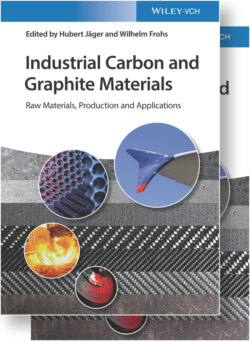Читать книгу Industrial Carbon and Graphite Materials - Группа авторов - Страница 253
5.2 Natural Graphite 5.2.1 Occurrence and Properties
ОглавлениеNumerous hypotheses on the genesis of natural graphite existed, but today most of them are outdated. It is currently supposed that organic matter was the origin of most natural graphites with the probable exception of the Sri Lanka (vein‐type) deposits. The origin of vein graphite deposits is still not certain. In regionally metamorphosed (granulitic, charnockitic) rocks, graphite is thought to form epigenetically from carbon‐rich hydrothermal or pneumatolytic solutions as interlocking aggregates of coarse graphite crystals in veins containing 75–100% carbon. Disseminated flake graphite deposits (see Figure 5.5) develop synergetically from carbonaceous material in sedimentary rocks that have been subjected to garnet grade or higher regional metamorphism. Concurrent large‐scale folding of the metasedimentary sequences is common, and fold limbs often host deposits. Deposits are usually stratabound and consist of individual beds or lenses in gneisses, schists, and marbles that are richer in graphite than associated beds [15]. Single flakes may range from 0.5 to 25 mm. The decomposition of compounds, e.g. carbide, carbonates, carbonyl, and cyano compounds, is less important for the genesis of graphite deposits.
Natural graphite is divided into vein type, flake type, and microcrystalline type, often incorrectly called amorphous graphite. Crystallinity, refractoriness, and other properties of natural graphite from different deposits may vary substantially because of differences in the precursor materials and the conditions of metamorphosis. In general, natural graphite is a ductile soft mineral that easily cleaves parallel to the basic layer. The flaky and vein grades show a typical metallic luster; the microcrystalline “amorphous” grades have a duller black appearance. Table 5.2 shows a classification [16, 17]. The host rocks consist of quartz, mica, gneiss, feldspars associated with pegmatite aplite, granite magnetite, and calcite.
Figure 5.5 Scanning electron microscopy (SEM) picture of a flake natural graphite.
Table 5.2 Classification of natural graphite.
| Deposit | Carbon content (%) | Average crystallite diameter (mm) | Origin | |
|---|---|---|---|---|
| Macrocrystalline flakes | Brazil | <60 | <0.1 | Syngenetic cata‐ and mesozonal metamorphism of sapropelites |
| Germany (Kropfmühl) | ||||
| China | ||||
| Canada | ||||
| Malagasy Republic | ||||
| Norway | ||||
| India | ||||
| Zimbabwe | ||||
| Russia | ||||
| Mozambique | ||||
| Tanzania | ||||
| Macrocrystalline lumps | Sri Lanka | <100 | <0.01 | Epigenetic, probably pneumatolytic |
| Mesocrystalline | Austria | 30–90 | <0.001 | Syngenetic metamorphism of sapropelites |
| Czech Republic | ||||
| Microcrystalline | China | 30–90 | <0.001 | Syngenetic, epizonal metamorphism of coals |
| Korea | ||||
| Russia | ||||
| Mexico Austria |
